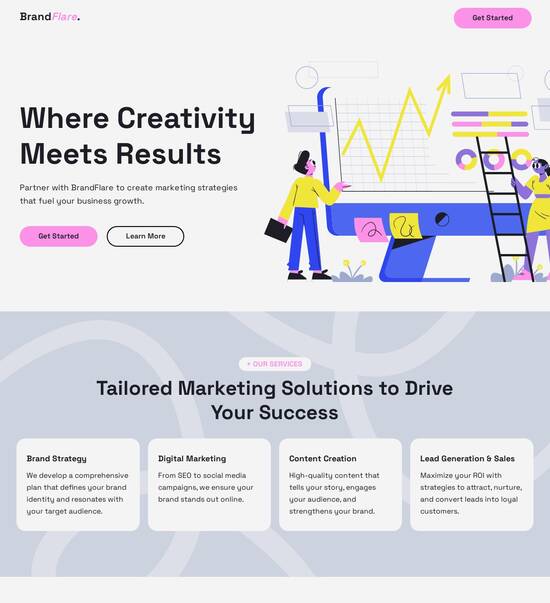
Web page template for Chief administrative officers
Use TemplateAbout template
Attract clients and showcase your skills with style using our landing page templates for Chief administrative officers. Let's convert those visitors into clients!
Recommended templates

Easy to build without coding
With the intuitive drag-and-drop builder, anyone on your team can create high-converting pages without any knowledge of code or design. Make enhancements to your landing page with custom widgets using Javascript, HTML/CSS, or third-party scripts.

Multiple layouts for any industry and goal
Select from 500+ landing page layouts built to boost conversions across industry-specific scenarios. Customize them by adjusting fonts, adding images, and generating on-brand content with the AI assistant. Quickly scale with Instablocks® and Global Blocks that you can save, reuse, and update globally.

Loads fast and looks polished on any device
Every template is responsive, which means they present professionally on any device and load blazingly fast with our Thor Render Engine. You can also power them up with Google AMP technology to deliver an unparalleled mobile experience and drive higher conversions.

Robust analytics & experimentation
Get real-time updates and reporting across all your devices, showing the number of visitors, conversions, cost-per-visitor, and cost-per-lead. Launch AI-powered experiments, run A/B tests, and use heatmaps to analyze user behavior, then optimize your landing page to maximize conversions.







Easy to build without coding
With the intuitive drag-and-drop builder, anyone on your team can create high-converting pages without any knowledge of code or design. Make enhancements to your landing page with custom widgets using Javascript, HTML/CSS, or third-party scripts.
Multiple layouts for any industry and goal
Select from 500+ landing page layouts built to boost conversions across industry-specific scenarios. Customize them by adjusting fonts, adding images, and generating on-brand content with the AI assistant. Quickly scale with Instablocks® and Global Blocks that you can save, reuse, and update globally.
Loads fast and looks polished on any device
Every template is responsive, which means they present professionally on any device and load blazingly fast with our Thor Render Engine.
Robust analytics & experimentation
Get real-time updates and reporting across all your devices, showing the number of visitors, conversions, cost-per-visitor, and cost-per-lead. Launch AI-powered experiments, run A/B tests, and use heatmaps to analyze user behavior, then optimize your landing page to maximize conversions.
All the features you need to build lead-generating landing pages
Explore more featuresLearn how to build top-performing landing pages for any goal
FAQs
Leading the way in building high-performing landing pages





An effective landing page template for marketing professionals
For marketing departments across various sectors, utilizing an optimized landing page template is crucial to drive conversions and maximize ROI. Instapage provides high-quality templates that cater specifically to the needs of businesses in services like marketing and advertising, technology, education, and more. By leveraging these templates, marketers can efficiently accelerate their campaigns without needing extensive technical skills.
Understanding the importance of landing pages
Landing pages serve as the critical entry point for potential customers. A well-designed landing page can make or break a marketing campaign. They are optimized for conversions and play an essential role in Customer Relationship Optimization (CRO). Businesses need to create tailored content that resonates with their target audiences and drives engagement.
- Target Audience Identification: Understand who your customers are and what they value to create landing pages that appeal directly to their needs.
- Conversion-Focused Design: Utilize design elements that guide users toward a single, clear goal, such as filling out a form or making a purchase.
- Analytics and Feedback Loop: Regularly analyze page performance using metrics like heatmaps to refine and improve the effectiveness of landing pages.
Step one: Selecting the right template
Choosing an appropriate landing page template is the first step in developing an engaging page. Instapage offers more than 100 customizable templates designed to maximize conversion.
Step two: Customizing the landing page
After selecting a template, customization is crucial. The platform allows marketing teams to easily modify elements to align with brand identity. Consider the following checkpoints:
- Visual Elements: Ensure consistency in colors, fonts, and images to keep your brand identity strong.
- Call-to-Action (CTA): Create CTA buttons that are clear and enticing; they should stand out on the page.
- Content Relevance: Make sure the copy on the landing page is targeted toward the specific audience for the campaign.
Step three: Optimize and test your landing page
Once your landing page is set up, it's vital to conduct A/B tests and utilize analytics tools to user behaviors. Key considerations include:
- A/B Testing: Run different versions of your landing page to see which performs better in terms of conversions.
- Heatmaps: Use heatmaps to determine how users interact with the page and identify areas for improvement.
- Feedback Implementation: Act on user feedback and data to continually refine and enhance your landing pages.
By following these steps, marketers can effectively harness Instapage's capabilities to improve their landing page performance dramatically.
Ready to boost your marketing strategies? Start leveraging Instapage's powerful templates today for optimized landing page solutions.
People also ask about Web page template for Chief administrative officers
Web page template for chief administrative officers
Understanding the role of the chief administrative officer (CAO)
The chief administrative officer (CAO) is a pivotal role within an organization, focusing on overseeing administrative functions, streamlining operations, and implementing strategies that align with the company's objectives. Traditionally, the CAO's role has evolved from pure administrative support to strategic involvement in decision-making processes. This evolution reflects broader changes in business environments, emphasizing Agile methodologies and cross-functionality.
Historically, the CAO served mainly as a senior manager reporting to the CEO or board of directors, primarily handling budgeting, human resources, and compliance issues. As business dynamics shifted, so did the responsibilities of the CAO, who now plays an integral part in shaping executive strategies and organizational frameworks. The CAO’s deep understanding of organizational structures and culture enables them to maintain a smooth operational flow while responding to both internal and external challenges.
A strong CAO provides leadership continuity and stability within the organization.
They bridge the gap between executive management and operational staff, ensuring effective communication and implementation of policies.
CAOs are essential in navigating regulatory landscapes, influencing the organization's ability to adapt and thrive.
Essential job description elements for a chief administrative officer
A well-defined job description for a CAO includes key responsibilities that encapsulate their role. These responsibilities typically involve overseeing administrative functions, aligning strategies with company goals, and managing regulatory compliance. Specifically, they are tasked with creating systems that promote efficient workflows, monitoring operational performance, and ensuring the organization complies with laws and regulations.
Collaboration with executive leadership is another vital responsibility. The CAO must work closely with other executives to ensure that various departments function cohesively toward common business objectives. This collaboration often extends to stakeholder engagement, ensuring that feedback is solicited and implemented to enhance organizational performance.
Key responsibilities of a CAO include overseeing administrative functions, collaborating with executive team members, and managing regulatory compliance.
Required skills for the role involve leadership and strategic planning capabilities, financial acumen, and effective communication.
Performance metrics for success can include operational efficiency, employee satisfaction, and the achievement of strategic objectives.
The recruitment landscape for CAOs
The hiring landscape for chief administrative officers continues to evolve. Organizations are increasingly recognizing the strategic value of the CAO role, leading to a heightened demand for qualified professionals. Current trends show that executive recruiters are looking for candidates not just with operational experience but also those who can drive innovation and foster organizational growth.
Essential qualities that recruiters focus on when hiring CAOs include strong leadership skills, a proven track record in strategic planning, and the ability to navigate complex regulatory environments. Candidates who demonstrate effective problem-solving skills and adaptability in change management are particularly attractive in today’s fast-paced business climate.
Current trends indicate a focus on hiring CAOs who possess leadership capabilities and strategic insight.
Recruiters value candidates who can drive innovation while maintaining regulatory compliance.
Developing an effective recruitment strategy includes leveraging external search firms or relying on internal talent acquisition teams.
Tailored recruitment resources for CAO candidates
Finding the right CAO candidate can often be challenging, but several tailored resources can simplify the recruitment process. Specialized job boards and platforms that focus on executive roles can help organizations reach their desired candidates quickly and efficiently. In addition to online resources, networking opportunities and events dedicated to executive professionals can prove invaluable for identifying potential hires.
Creating a compelling resume is crucial for CAO candidates. Best practices include emphasizing relevant experiences, demonstrating leadership skills, and showcasing contributions to strategic initiatives that reflect personal growth and career advancement. Moreover, utilizing social media for job searches has emerged as a crucial strategy, enabling candidates to broaden their reach and connect with industry leaders.
Job boards specific to executive roles can significantly enhance recruitment efforts.
Networking opportunities and events provide platforms for connecting with potential CAO candidates.
Best practices for crafting a resume include highlighting relevant experiences and showcasing leadership contributions.
Harnessing web page templates for engaging CAO recruitment
When it comes to recruiting a CAO, the design and structure of the web page template used can significantly impact engagement and applicant interest. An ideal web page template for CAO recruitment should combine functionality with aesthetics, ensuring that potential candidates find the application process straightforward and inviting. Such templates should be customizable to reflect the organization’s culture, making a strong first impression.
Key features to look for in a CAO recruitment template include user-friendly navigation for candidates, seamless integration of SEO best practices to enhance visibility, and visual design elements that appeal to executive-level candidates. The use of high-quality images, clean layouts, and concise messaging can significantly enhance the overall user experience.
Customizability to reflect the organization's unique culture can help attract the right candidates.
User-friendly navigation ensures candidates have a hassle-free experience when applying.
SEO best practices integrated into the template will improve visibility and attract more qualified applicants.
Benefits of using web page templates in CAO recruitment
Leveraging web page templates in CAO recruitment offers numerous advantages. First and foremost, these templates simplify the application process, making it easier to track and manage candidates effectively. By standardizing the application experience, organizations can streamline workflows, allowing recruitment teams to focus on evaluating candidates rather than sorting through unorganized submissions.
Enhanced candidate engagement is another significant benefit. Use of visuals in the recruitment process can grab the attention of potential candidates, making the experience more interactive and enjoyable. Furthermore, adopting web page templates is cost-effective compared to traditional hiring methods, aiding in maximizing return on investment. In addition, they strengthen brand identity by presenting a cohesive and attractive image to prospective candidates.
Templates streamline the application process, making candidate tracking more efficient.
Visual engagement through templates enhances the overall experience for candidates.
Adopting templates is cost-effective compared to traditional hiring methods.
Crafting content that resonates with prospective CAOs
To attract the right candidates for the CAO position, it is crucial to craft content that effectively communicates organizational values and culture. Highlighting these aspects helps potential candidates gauge their fit within the organization’s framework. Additionally, clearly outlining business goals and expectations allows candidates to understand what success looks like and what contribution is required of them.
Presenting growth opportunities and realistic career pathways is equally important. This transparency aids in attracting ambitious candidates who are not just looking for a job but a place to grow their careers. Employing testimonials from current leadership can provide insight into the organization's culture and values, giving potential applicants a clearer picture of working within the business.
Highlighting organizational values and culture attracts candidates who share similar principles.
Clearly communicating business goals outlines expectations for potential CAOs.
Using testimonials from current leadership provides insight into the organization's environment.
Essential steps for optimizing CAO landing pages
Once a CAO recruitment landing page is established, optimizing it becomes crucial for attracting the right candidates. One essential step is analyzing user behavior and feedback to understand how applicants interact with the site. Gathering insights into user navigation patterns can highlight areas for improvement and streamline the application process.
A/B testing also plays a pivotal role in identifying layout and content effectiveness. Testing different versions of landing pages can provide valuable feedback on what elements resonate most with candidates. Additionally, implementing analytics tools will help measure performance against set key performance indicators (KPIs), ensuring continuous improvement in the recruitment process.
Analyzing user behavior helps identify areas for improving the landing page experience.
A/B testing various layouts and content informs better design decisions.
Using analytics tools allows for ongoing assessment of landing page effectiveness.
Innovative solutions to enhance the recruitment process
As competition for CAO talent intensifies, organizations must incorporate innovative solutions to enhance the recruitment process. One such solution is integrating AI and automation for screening candidates. By using AI-driven tools, organizations can increase efficiency in identifying qualified candidates while reducing biases in the selection process.
Incorporating video content and interactive elements on landing pages can also provide a more engaging experience for prospective CAOs. Such content allows candidates to visualize the organization’s culture and understand their potential role. Furthermore, leveraging webinars and virtual Q&A sessions can create a direct line of communication between candidates and current leaders, fostering a deeper sense of belonging and connection prior to hiring.
Utilizing AI helps streamline candidate screening and reduces selection biases.
Interactive and video content on landing pages ensures a more engaging candidate experience.
Webinars and virtual Q&A sessions foster connections between candidates and leadership.
Guidance for recruiters in CAO selection and onboarding
The selection and onboarding of a CAO require a thoughtful approach. Developing a comprehensive interview framework helps ensure that each candidate is assessed consistently. This framework should cover qualitative and quantitative competencies and gauge alignment with the company’s strategic goals and culture.
Furthermore, ensuring alignment between the CAO's roles and the organization's objectives is critical. This alignment can be solidified through ongoing support post-hire. Providing mentorship and integration resources not only facilitates a smoother transition for the new CAO but also strengthens their alignment with the organization’s strategic vision.
A comprehensive interview framework ensures consistent evaluation of candidates.
Ensuring alignment between the CAO's role and business objectives is crucial for success.
Continuous support post-hire, including mentorship, enhances integration and alignment.
The strategic impact of a successful CAO recruitment process
A successful CAO recruitment process goes beyond simply filling a position; it plays a key role in aligning the new leader with long-term business goals. By choosing a CAO whose vision aligns with the organization’s mission, businesses can foster transformative leadership that actively drives success. Therefore, the strategic selection process can have significant long-term implications for overall organizational performance.
Measuring the impact of a new CAO on organizational performance necessitates the establishment of clear metrics. Such metrics might involve operational efficiency, engagement levels among staff, or improvements in regulatory compliance. Incorporating feedback mechanisms allows organizations to adapt and enhance the recruitment and onboarding process continuously, positioning them for ongoing success.
Aligning the new CAO with business goals enhances organizational performance.
Establishing metrics helps measure the impact of the CAO on performance.
Feedback mechanisms promote continuous improvement in recruitment and onboarding.
Future trends influencing CAO roles and recruitment
The landscape of administrative functions within organizations is experiencing notable changes that influence the CAO role. Emerging technologies such as AI and automation are reshaping administrative responsibilities, offering greater efficiency and insight for CAOs as they navigate their tasks. Moreover, remote working trends are altering how CAOs lead their teams and organize resources.
In addition to technological advancements, CAOs must also prepare for industry shifts that could impact their roles. Understanding market trends, economic indicators, and social changes will provide CAOs with the agility needed to adapt quickly and effectively. Organizations that foster environments of continuous learning and adaptation are more likely to thrive in this evolving administrative landscape.
Technology is reshaping the functions of CAOs, emphasizing the need for adaptability.
Remote work trends are changing how CAOs manage teams and resources.
Continuous learning and adaptability will be critical for organizational success.
Ready to skyrocket conversions?
Supercharge your ad campaigns with high-performing landing pages
Get started














